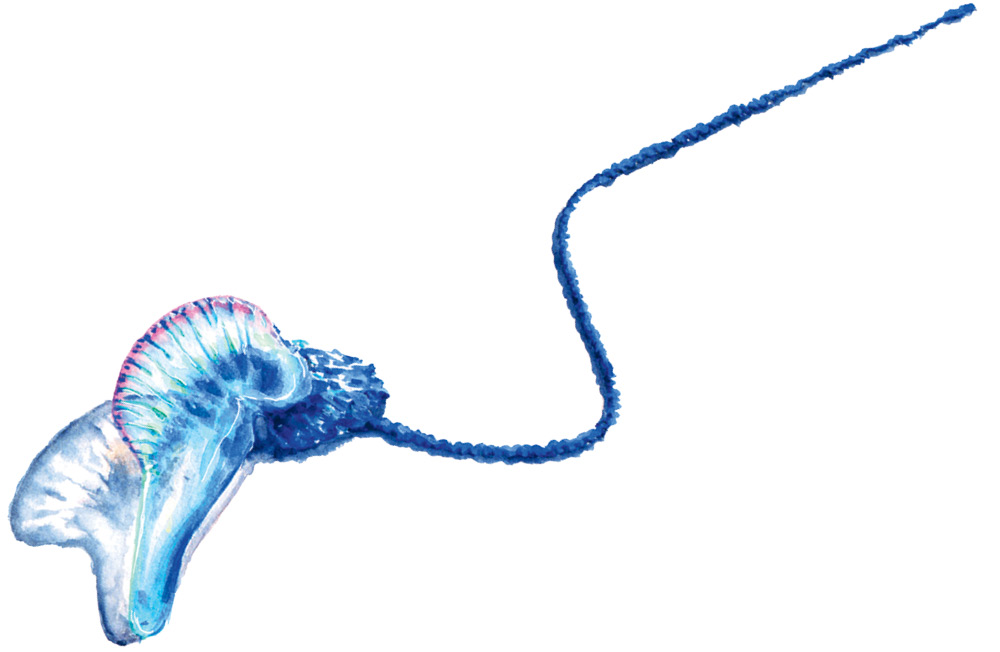The Short History Of Bluebottles
Share
There are rare instances when creationism and evolution are nothing more than competing studies in pointlessness.
Would an omniscient God – in the six frantic days when He devised fossils, the North Pacific Oscillation, and Rosy Hodge – really have come up with a creature that exists for no better reason than to inflict misery on the populace? (Alan Jones, don’t answer that). Or would a patient process of natural selection have done away with legs, arms, flippers, and claws to leave a disco-blue gelatinous blob floating on the currents until it crashes helplessly into a Sunday morning nippers session?
Not likely.
The answer is stranger than Genesis and Mendel combined. The bluebottle, AKA the Pacific man-o-war, is not a true jellyfish. It is in fact a colony of four separate individuals – the float (pneumatophore), tentacles (dactylozooids), digestive polyps (gastrozooids), and reproductive polyps (gonozooids). The relentless separatism of these four creatures, like flatmates with their doors slammed shut, has prevented them organising into anything more useful than an upside-down polyester handbag full of two minute noodles.
Their close relatives, the corals and sea anemones, have managed to make a reasonable fist of their ludicrous composition. The bluebottle, meanwhile, has made a career out of malevolence. Being hermaphrodites, they don’t even have to be nice to an opposite gender.
The zenith of bluebottle design genius is, of course, reserved for its stingers (nematocysts). Just one one-thousandth of a millimetre in diameter (now you know why you can never find the bastards with tweezers), each one is like a miniature bubble, but with its wall turned inwards at one point to form a coiled squiggle inside. The squiggle’s protected by a hinged lid on the outside. When some other part of the polyester handbag yells, “Defenceless booger!” the squiggle turns itself inside out and shoots forwards. It’s covered in tiny barbs laced with substances more toxic than a Cory Bernardi press release. Now imagine this mechanism occurring a thousand times over every millimetre of the tentacles’ surface area, and you see why even the Tokyo Shock Boys won’t go near them.
Following on from last issue’s study of thongs, bluebottles are also biased to either the left or right, the idea being that if pain and distress can be inflicted on two separate groups of surfers but the wind is only blowing one way, at least half the colony will get to inflict it.
But it’s time of course, like a drunk best man’s wedding speech, to do the bit where we go “nah nah seriously, shoosh”. These are miraculous animals. A bluebottle can grow ten-to-15 centimetres in float length, and can capture and kill a fish of the same size, which is no mean feat. They were the feature of John Olsen’s 2007 masterpiece Popping Bluebottles, and the subject of Matt Smith’s amazing under/over water strobe photography. They’re more prevalent in the semi-tropics –Snapper over Bells – which might be due to the effects of not only water temperature, but also the East Australian Current.
The only creature in the entire sea that is known to be immune to the venom of the bluebottle is a slug named Glaucus Altanticus, which actually eats them. Obviously this is the work of a lunatic organism, and Glaucus doesn’t disappoint – it looks like an indigo porcelain bong with fins.
Folk remedies for bluebottle stings are as numerous and irrational as Trump supporters. Ice, vinegar, and rubbing do not work. Wheatgrass and aloe vera might. Pissing on the affected area is just a double pay-off for the bluebottle: not only did I flame your arse, but now you’re making a fool of yourself. Hot water is the only known answer.
But when you’re feeling the burn and begging for amputation, remember, there has not been a single fatality to bluebottle stings in Australian waters. More people die from, er… shark attacks.
